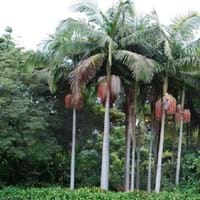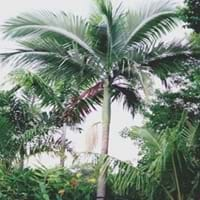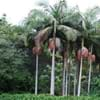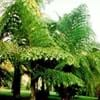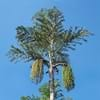Life Span
Perennial
Perennial
Type
Palm or Cycad
Palm or Cycad
Origin
Australia
Australia
Types
Alexandra King palm, Purple King Palm
Walsch River Palm
King Palm
Myola King Palm
Purple Crown Shaft King Palm
Peach River Palm
Habitat
Clay soil areas, Woodlands
Coastal Mountains, Coastal Regions, gardens, Suburban areas
USDA Hardiness Zone
10-11
10-14
Sunset Zone
H1, H2, 21, 22, 23, 24
H1, H2, 21, 22, 23, 24
Habit
Arching/Fountain-shaped
Arching/Fountain-shaped
Flower Color
Purple, Lavender
White, Yellow, Lavender
Flower Color Modifier
Bicolor
Bicolor
Fruit Color
Red, Pink
Red
Leaf Color in Spring
Light Green, Gray Green
Green, Silver
Leaf Color in Summer
Light Green, Gray Green
Green, Silver
Leaf Color in Fall
Light Green, Gray Green
Green, Silver
Leaf Color in Winter
Light Green, Gray Green
Green, Silver
Leaf Shape
Pinnate
Long Elliptic
Plant Season
Spring, Summer, Fall, Winter
Spring, Summer, Fall, Winter
Sunlight
Full Sun, Partial Sun, Partial shade
Full Sun, Partial Sun
Type of Soil
Loam
Clay, Loam, Sand
The pH of Soil
Acidic, Neutral
Acidic, Neutral
Soil Drainage
Well drained
Well drained
Bloom Time
Summer
Indeterminate
Tolerances
Wet Site, Drought
Wet Site
Where to Plant?
Ground
Ground
How to Plant?
Seedlings
Seedlings
Plant Maintenance
Medium
Medium
Watering Requirements
occasional watering once established, Water daily during growing season
Do not water frequently, Keep the ground moist but not water-logged, Over-watering can cause leaf problems or root diseases, Water Deeply
In Summer
Lots of watering
Lots of watering
In Spring
Moderate
Moderate
In Winter
Average Water
Average Water
Soil pH
Acidic, Neutral
Acidic, Neutral
Soil Type
Loam
Clay, Loam, Sand
Soil Drainage Capacity
Well drained
Well drained
Sun Exposure
Full Sun, Partial Sun, Partial shade
Full Sun, Partial Sun
Pruning
Remove dead leaves, Remove old, faded fronds
Prune if you want to improve plant shape, Remove deadheads, Remove shoots
Fertilizers
Potassium, slow-release fertilizers
All-Purpose Liquid Fertilizer
Pests and Diseases
Moth, Pink Root, Red spider mite
Red blotch
Plant Tolerance
Salt, Soil Compaction, Sun
Drought
Flower Petal Number
Single
Single
Foliage Texture
Bold
Bold
Foliage Sheen
Glossy
Glossy
Invasive
Sometimes
Sometimes
Attracts
Beetles, Mice, Moths
Not Available
Allergy
breathing problems, Pollen, Runny nose, sneezing
no allergic reactions
Aesthetic Uses
Decorating walls, Landscape Designing, Showy Purposes
Beautification
Beauty Benefits
Making cosmetics, Removes dandruff, Skin inflammation
Not Available
Environmental Uses
Air purification, Shadow Tree
Air purification
Medicinal Uses
Antibacterial, Anti-fungal, Bone disorders, Chronic fatigue, Cyanide Poisoning, Emmoiliant, High cholestrol, Malaria, Metabolic disorders, Piles, Vitamin A, Weight loss
Not Available
Part of Plant Used
Fruits, Leaves, Tree trunks
Whole plant
Other Uses
Application in Handicrafts, Biomass for fuel, For making oil, Jelly, Making Shampoo, Sometimes used for making wine, Used as Ornamental plant, Used in salads, Wax
Decoration Purposes, Used as Ornamental plant
Used As Indoor Plant
No
No
Used As Outdoor Plant
Yes
Yes
Garden Design
Feature Plant, Tropical
Container, Feature Plant, Street Trees, Tropical, Water Gardens
Botanical Name
ARCHONTOPHOENIX cunninghamiana
ARCHONTOPHOENIX alexandrae
Common Name
Bangalow Palm, King Palm, Piccabeen Palm
Alex Palm, Alexandra Palm, Princess Alexandra Palm
In Hindi
Palm
Alexandra palm
In German
Palme
Alexandra palm
In French
Paume
Alexandra palme
In Spanish
Palma
Alexandra palma
In Greek
Παλάμη
Αλεξάνδρα παλάμη
In Portuguese
Palma
Alexandra palma
In Polish
Palma
Alexandra dłoni
In Latin
Vero
Alexandra palma
Phylum
Angiosperms
Not Available
Class
Liliopsida
Liliopsida
Family
Arecaceae
Arecaceae
Genus
Archontophoenix
Archontophoenix
Clade
Angiosperms, Commelinids, Monocots
Not Available
Subfamily
Arecoideae
Arecoideae
Number of Species
Not Available
Importance of King Palm and Alexandra Palm
Want to have the most appropriate plant for your garden? You might want to know the importance of King Palm and Alexandra Palm. Basically, these two plants vary in many aspects. Compare King Palm and Alexandra Palm as they differ in many characteristics such as their life, care, benefits, facts, etc. Every gardener must at least have the slightest clue about the plants he wants to plant in his garden. Compare their benefits, which differ in many ways like facts and uses. The medicinal use of King Palm is Antibacterial, Anti-fungal, Bone disorders, Chronic fatigue, Cyanide Poisoning, Emmoiliant, High cholestrol, Malaria, Metabolic disorders, Piles, Vitamin A and Weight loss whereas of Alexandra Palm is Not Available. King Palm has beauty benefits as follows: Making cosmetics, Removes dandruff and Skin inflammation while Alexandra Palm has beauty benefits as follows: Making cosmetics, Removes dandruff and Skin inflammation.
Compare Facts of King Palm vs Alexandra Palm
How to choose the best garden plant for your garden depending upon its facts? Here garden plant comparison will help you to solve this query. Compare the facts of King Palm vs Alexandra Palm and know which one to choose. As garden plants have benefits and other uses, allergy is also a major drawback of plants for some people. Allergic reactions of King Palm are breathing problems, Pollen, Runny nose and sneezing whereas of Alexandra Palm have no allergic reactions respectively. Having a fruit bearing plant in your garden can be a plus point of your garden. King Palm has showy fruits and Alexandra Palm has showy fruits. Also King Palm is not flowering and Alexandra Palm is not flowering . You can compare King Palm and Alexandra Palm facts and facts of other plants too.
